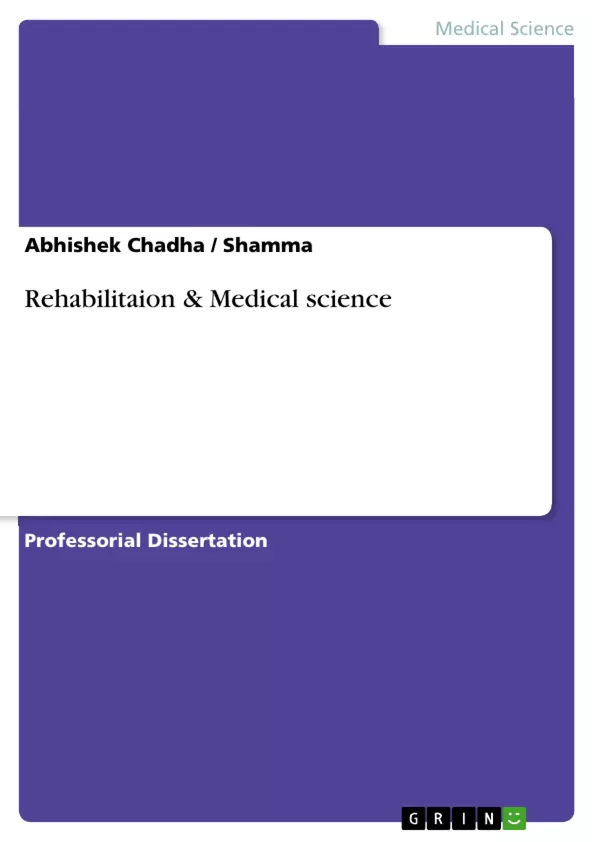The book Rehabilitation & Medical Science has been published with the personal experience in the field of rehabilitation and the medical sciences. The author of the project is also a co-author book "Physical Medicine & Rehabilitation" (A way to live a happy life). The author is a member of national society working in this field.
Inhaltsverzeichnis (Table of Contents)
- History
- Introduction - Rehabilitation & Physiotherapy
- Prevention of disability
- How to diagnose a disability
- Functional diagnosis
- Rating of disability
- When to start the Rehabilitation
- Rehabilitation team
- Role of Social Worker
- Role of NGO's
- Classification of handicapped
- New hopes for the Disabled
- Persons with Disability Act
- Concession to Physically Challenged Persons
- Aids & Appliances
- Orthotic Appliances
- Amputations
- Level of Amputations
- Type of Amputations
- Rehabilitation of amputees
- Prosthetic appliances
- Training
- Walking aids
- Rehabilitation of a stroke patient
- Facilities Provided by Indian Red Cross
- Draw Backs & Suggestions
Zielsetzung und Themenschwerpunkte (Objectives and Key Themes)
This text explores the history of rehabilitation for individuals with disabilities, examining the evolution of societal attitudes and practices. It highlights the multifaceted nature of disability and its impact on individuals, families, and communities. The text emphasizes the need for a comprehensive approach to rehabilitation, considering both medical and social aspects.- The historical context of disability and societal perceptions
- The importance of a holistic approach to rehabilitation, encompassing medical, social, and economic factors
- The evolving role of rehabilitation in promoting inclusion and reducing the impact of disability
- The need for accessible healthcare and support services for individuals with disabilities
- The challenges and opportunities facing the field of rehabilitation in a changing world
Zusammenfassung der Kapitel (Chapter Summaries)
- Introduction - Rehabilitation & Physiotherapy: This introductory chapter defines rehabilitation and physiotherapy, explaining their role in preventing and managing disabilities. It discusses various methods for diagnosing disability, including functional diagnosis and rating systems.
- When to start the Rehabilitation: This chapter delves into the timing and components of rehabilitation, introducing the rehabilitation team and emphasizing the contributions of social workers and non-governmental organizations (NGOs). It also explores the classification of handicapped individuals.
- New hopes for the Disabled: This chapter examines advancements in disability rights and support, highlighting the Persons with Disability Act, concessions for physically challenged individuals, and the importance of aids and appliances, such as orthotic devices.
- Amputations: This chapter focuses on amputations, detailing different levels and types of amputation procedures. It explores the rehabilitation process for amputees, including the use of prosthetic appliances, training, and walking aids.
- Rehabilitation of a stroke patient: This chapter specifically addresses the rehabilitation of stroke patients, outlining the necessary interventions and therapies.
- Facilities Provided by Indian Red Cross: This chapter describes the resources and services offered by the Indian Red Cross organization for individuals with disabilities.
Schlüsselwörter (Keywords)
Disability, rehabilitation, physiotherapy, prevention, diagnosis, functional diagnosis, rating of disability, rehabilitation team, social worker, NGO, handicapped, Persons with Disability Act, concessions, aids and appliances, orthotic appliances, amputations, rehabilitation of amputees, prosthetic appliances, stroke, Indian Red Cross. - Introduction - Rehabilitation & Physiotherapy
Excerpt out of 51 pages
- scroll top
- Quote paper
- Physical therapist Abhishek Chadha (Author), Dr. Shamma (Author), 2013, Rehabilitaion & Medical science, Munich, GRIN Verlag, https://www.grin.com/document/263740
Look inside the ebook



